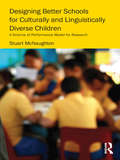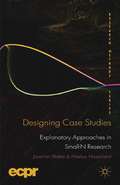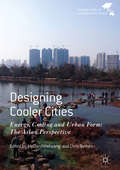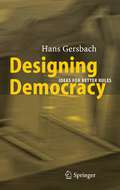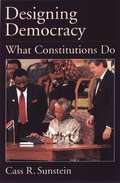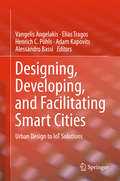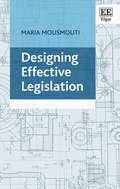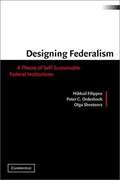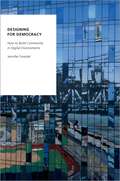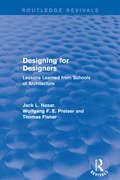- Table View
- List View
Designing Better Schools for Culturally and Linguistically Diverse Children: A Science of Performance Model for Research
by Stuart McNaughtonHow can schools be better designed to enable equitable academic outcomes for culturally and linguistically diverse children from communities lacking in economic, political and social power? Putting forward a robust ‘science of performance’ model of school change based on a specified process of research and development in local contexts, this book: lays out the traditions of optimism and pessimism about effective schooling for at-risk students reviews the international and national evidence for the effectiveness of schools and school systems in reducing disparities in achievement describes the challenges educational research must address to solve the problem of school effectiveness, proposes strict criteria against which effectiveness should be judged, and examines in detail examples where change has been demonstrated proposes how researchers, professionals, and policy-makers can develop more effective systems. Bringing together structural and psychological accounts of the nature of schools, and establishing theoretically defensible criteria for judging effectiveness, this book is a critically important contribution to advancing the science of making schools more effective.
Designing Better Schools for Culturally and Linguistically Diverse Children: A Science of Performance Model for Research
by Stuart McNaughtonHow can schools be better designed to enable equitable academic outcomes for culturally and linguistically diverse children from communities lacking in economic, political and social power? Putting forward a robust ‘science of performance’ model of school change based on a specified process of research and development in local contexts, this book: lays out the traditions of optimism and pessimism about effective schooling for at-risk students reviews the international and national evidence for the effectiveness of schools and school systems in reducing disparities in achievement describes the challenges educational research must address to solve the problem of school effectiveness, proposes strict criteria against which effectiveness should be judged, and examines in detail examples where change has been demonstrated proposes how researchers, professionals, and policy-makers can develop more effective systems. Bringing together structural and psychological accounts of the nature of schools, and establishing theoretically defensible criteria for judging effectiveness, this book is a critically important contribution to advancing the science of making schools more effective.
Designing Case Studies: Explanatory Approaches in Small-N Research (ECPR Research Methods)
by J. Blatter M. HaverlandThe authors explore three ways of conducting causal analysis in case studies. They draw on established practices as well as on recent innovations in case study methodology and integrate these insights into coherent approaches. They highlight the core features of each approach and provide advice on each step of the research process.
Designing Cities with Children and Young People: Beyond Playgrounds and Skate Parks
by Kate Bishop Linda CorkeryDesigning Cities with Children and Young People focuses on promoting better outcomes in the built environment for children and young people in cities across the world. This book presents the experience of practitioners and researchers who actively advocate for and participate with children and youth in planning and designing urban environments. It aims to cultivate champions for children and young people among urban development professionals, to ensure that their rights and needs are fully acknowledged and accommodated. With international and interdisciplinary contributors, this book sets out to build bridges and provide resources for policy makers, social planners, design practitioners and students. The content moves from how we conceptualize children in the built environment, what we have discovered through research, how we frame the task and legislate for it, and how we design for and with children. Designing Cities with Children and Young People ultimately aims to bring about change to planning and design policies and practice for the benefit of children and young people in cities everywhere.
Designing Cities with Children and Young People: Beyond Playgrounds and Skate Parks
by Kate Bishop and Linda CorkeryDesigning Cities with Children and Young People focuses on promoting better outcomes in the built environment for children and young people in cities across the world. This book presents the experience of practitioners and researchers who actively advocate for and participate with children and youth in planning and designing urban environments. It aims to cultivate champions for children and young people among urban development professionals, to ensure that their rights and needs are fully acknowledged and accommodated. With international and interdisciplinary contributors, this book sets out to build bridges and provide resources for policy makers, social planners, design practitioners and students. The content moves from how we conceptualize children in the built environment, what we have discovered through research, how we frame the task and legislate for it, and how we design for and with children. Designing Cities with Children and Young People ultimately aims to bring about change to planning and design policies and practice for the benefit of children and young people in cities everywhere.
Designing Community: Design-based Planning For Communities
by David WaltersGreenfield sites around towns and cities, and redevelopment infill sites in existing urban areas often become battlegrounds between the conflicting interests of developers and communities. In America, design charrettes (intensive design and planning workshops) have become widely used as a means of bringing together these divergent groups, using detailed design exercises to establish agreement around a development masterplan. Despite the increasing frequency of their use, charrettes are widely misunderstood and can be misapplied. This book provides a detailed guidance on the proper and most effective ways to use this helpful tool. The book combines charrette masterplanning with the creation of "design-based" codes (also known as "form-based" codes) to control the development's implementation in line with the design and planning principles established during the charrette process.
Designing Community
by David WaltersGreenfield sites around towns and cities, and redevelopment infill sites in existing urban areas often become battlegrounds between the conflicting interests of developers and communities. In America, design charrettes (intensive design and planning workshops) have become widely used as a means of bringing together these divergent groups, using detailed design exercises to establish agreement around a development masterplan. Despite the increasing frequency of their use, charrettes are widely misunderstood and can be misapplied. This book provides a detailed guidance on the proper and most effective ways to use this helpful tool. The book combines charrette masterplanning with the creation of "design-based" codes (also known as "form-based" codes) to control the development's implementation in line with the design and planning principles established during the charrette process.
Designing Competitive Electricity Markets (International Series in Operations Research & Management Science #13)
by Hillard G. Huntington Hung-Po ChaoDesigning Cooler Cities: The Asian Perspective (PDF)
by Ali Cheshmehzangi Chris ButtersThis edited book surveys the major sustainability challenges facing Asian cities, in particular those related to urban energy and city cooling. The book discusses the key concepts and issues involved, addressing the three levels of micro (individual buildings), meso (neighbourhoods/districts) and macro (whole or large parts of cities). It illustrates different paradigms of urban development and explores how to create cooler cities by applying integrated sustainable design and planning on all three levels, bridging the gap between specialist approaches by highlighting both built projects, processes, and research. It also raises questions about prevalent paradigms of urban development as well as topics relating to urban district cooling solutions, sustainable construction materials, and processes towards effective delivery of sustainable cities. Providing cutting edge insights into hot climate cities in Asia, this text is also pertinent for the study of cities in other world regions, notably in developing countries, and of broad relevance to sustainable urban planning in all contexts.
Designing Criminal Tribunals: Sovereignty and International Concerns in the Protection of Human Rights
by Steven D. RoperTracing the development of international humanitarian law especially since World War II, this volume focuses on the role of the international community in crafting international and mixed war crimes tribunals. It examines the cases of the former Yugoslavia, Rwanda, Sierra Leone, Cambodia and East Timor. These tribunals are legal institutions embedded within a political environment in which the need for nation-state consensus can undermine their judicial effectiveness and ultimately the quest for justice. One of the principal themes examined is how the demands of state sovereignty and finance have contributed to the constant innovation of these tribunals. This is the only book available covering the breadth of cases and it places these institutions within the general development of international humanitarian law.
Designing Criminal Tribunals: Sovereignty and International Concerns in the Protection of Human Rights
by Steven D. RoperTracing the development of international humanitarian law especially since World War II, this volume focuses on the role of the international community in crafting international and mixed war crimes tribunals. It examines the cases of the former Yugoslavia, Rwanda, Sierra Leone, Cambodia and East Timor. These tribunals are legal institutions embedded within a political environment in which the need for nation-state consensus can undermine their judicial effectiveness and ultimately the quest for justice. One of the principal themes examined is how the demands of state sovereignty and finance have contributed to the constant innovation of these tribunals. This is the only book available covering the breadth of cases and it places these institutions within the general development of international humanitarian law.
Designing Democracy: Ideas for Better Rules
by Hans A. GersbachWhile liberal democracies are the best systems of self-governance for societies, they rarely invoke great enthusiasm. On the one hand, democracies have been known to fail in achieving efficient or fair allocations. On the other hand, many citizens take the democratic system for granted as they have yet to experience an alternative. In this book the vision we propose is that the potential of democ racies has not yet been exhausted, and that optimal democracies are both the Utopia for societies and the aim that scientists should be committed to. We present a number of ideas for drawing up new rules to im prove the functioning of democracies. The book falls into two parts. The first part examines ways of combining incentive contracts with democratic elections. We suggest that a judicious combina tion of these two elements as a dual mechanism can alleviate a wide range of political failures, while at the same time adhering to the founding principles of democracies. The second part presents new rules for decision-making and agenda setting. Together with modern communication devices, these rules can sometimes transcend the limitations of liberal VI Preface democracies in achieving desirable outcomes. Examples of such rules include the flexible majority rule where the size of the ma jority required depends on the proposal, or the rule that only those belonging to the winning majority can be taxed.
Designing Democracy: EU Enlargement and Regime Change in Post-Communist Europe
by G. PridhamDesigning Democracy is the first systematic and in-depth study of the effects of the EU's democratic conditionality, originally set out in the Copenhagen conditions of 1993, on the new political systems of Central and Eastern Europe. Using new material drawn from extensive elite interviews in several of these countries as well as in Brussels, the book throws much light on how far the EU enlargement process has really strengthened these new post-Communist democracies following their transitions in the 1990s.
Designing Democracy: What Constitutions Do
by Cass R. Sunstein"In modern nations, political disagreement is the source of both the gravest danger and the greatest security," writes Cass Sunstein. All democracies face intense political conflict. But is this conflict necessarily something to fear? In this provocative book, one of our leading political and legal theorists reveals how a nation's divisions of conviction and belief can be used to safeguard democracy. Confronting one explosive political issue after another, from presidential impeachment to the limits of religious liberty, from discrimination against women and gays to the role of the judiciary, Sunstein constructs a powerful new perspective from which to show how democracies negotiate their most divisive real-world problems. He focuses on a series of concrete concerns that go to the heart of the relationship between the idea of democracy and the idea of constitutionalism. Illustrating his discussion with examples from constitutional debates and court-cases in South Africa, Eastern Europe, Israel, America, and elsewhere, Sunstein takes readers through a number of highly charged questions: When should government be permitted to control discriminatory behavior by or within religious organizations? Does it make sense to govern on the basis of popular referenda? Can the right to have an abortion be defended? Can we defend Internet regulation? Should the law step in if children are being schooled in discriminatory preferences and beliefs? Should a constitution protect rights to food, shelter, and health care? Disputes over questions such as these can be fierce enough to pose a grave threat. But in a paradox whose elaboration forms the core of Sunstein's book, it is a nation's apparently threatening diversity of opinion that can ensure its integrity. Extending his important recent work on the way deliberation within like-minded groups can produce extremism, Sunstein breaks new ground in identifying the mechanisms behind political conflict in democratic nations. At the same time, he develops a profound understanding of a constitutional democracy's system of checks and balances. Sunstein shows how a good constitution, fostering a "republic of reasons," enables people of opposing ethical and religious commitments to reach agreement where agreement is necessary, while making it unnecessary to reach agreement when agreement is impossible. A marvel of lucid, subtle reasoning, DESIGNING DEMOCRACY makes invaluable reading for anyone concerned with the promises and pitfalls of the democratic experiment.
Designing Denuclearization: An Interpretive Encyclopedia
by Bruce LarkinThis work canvasses nuclear weapon abolition, proposals placed on the table since 1945 and the obstacles and issues which a realistic program for abolition confronts today. It has an ambitious purpose, to show that nuclear abolition can and should be placed on the public agenda.a The author terms it interpretive in that it incorporates his commentaries, never hiding his reasons and judgments. It is neither "just the facts" nor "all the facts." It is an encyclopedia in the original meaning of "a general course of instruction." He identifies himself with all who pursue the problem posed by nuclear weapons systematically and with seriousness of purpose, committed to self-instruction. In another sense, he writes, this work is a conversation with the Reader.What is needed to abolish nuclear weapons? His starting-point is this: As long as nuclear weapons are stockpiled and deployed there is risk of their use, which would be catastrophic. Abolition, however, is inconceivable in the absence of a developed and articulated alternative to the nuclear status quo. Even with that, the politics of abolition, bringing the governments of the nuclear weapon states to believe that abolition is in their interest, is the sine qua non of achieving a world free of nuclear weapons.Larkin's text is written for those, whether practitioners or citizens, interested in designing and bringing about denuclearization. Abolition cannot be achieved by political elites in the absence of broad concurrent public support. Governments, career policy officials and legislators have chosen to assume responsibility for the public agenda. They may be askedimust be asked,what they will do to bring about denuclearization.
Designing Denuclearization: An Interpretive Encyclopedia
by Bruce LarkinThis work canvasses nuclear weapon abolition, proposals placed on the table since 1945 and the obstacles and issues which a realistic program for abolition confronts today. It has an ambitious purpose, to show that nuclear abolition can and should be placed on the public agenda.a The author terms it interpretive in that it incorporates his commentaries, never hiding his reasons and judgments. It is neither "just the facts" nor "all the facts." It is an encyclopedia in the original meaning of "a general course of instruction." He identifies himself with all who pursue the problem posed by nuclear weapons systematically and with seriousness of purpose, committed to self-instruction. In another sense, he writes, this work is a conversation with the Reader.What is needed to abolish nuclear weapons? His starting-point is this: As long as nuclear weapons are stockpiled and deployed there is risk of their use, which would be catastrophic. Abolition, however, is inconceivable in the absence of a developed and articulated alternative to the nuclear status quo. Even with that, the politics of abolition, bringing the governments of the nuclear weapon states to believe that abolition is in their interest, is the sine qua non of achieving a world free of nuclear weapons.Larkin's text is written for those, whether practitioners or citizens, interested in designing and bringing about denuclearization. Abolition cannot be achieved by political elites in the absence of broad concurrent public support. Governments, career policy officials and legislators have chosen to assume responsibility for the public agenda. They may be askedimust be asked,what they will do to bring about denuclearization.
Designing, Developing, and Facilitating Smart Cities: Urban Design to IoT Solutions
by Vangelis Angelakis Elias Tragos Henrich C. Pöhls Adam Kapovits Alessandro BassiThis book discusses how smart cities strive to deploy and interconnect infrastructures and services to guarantee that authorities and citizens have access to reliable and global customized services. The book addresses the wide range of topics present in the design, development and running of smart cities, ranging from big data management, Internet of Things, and sustainable urban planning. The authors cover - from concept to practice – both the technical aspects of smart cities enabled primarily by the Internet of Things and the socio-economic motivations and impacts of smart city development. The reader will find smart city deployment motivations, technological enablers and solutions, as well as state of the art cases of smart city implementations and services.· Provides a single compendium of the technological, political, and social aspects of smart cities;· Discusses how the successful deployment of smart Cities requires a unified infrastructure to support the diverse set of applications that can be used towards urban development;· Addresses design, development and running of smart cities, including big data management and Internet of Things applications.
Designing Effective Legislation
by Maria MousmoutiWhat is effective legislation? Can lawmakers around the world improve the effectiveness of their laws? And if yes, how? Designing Effective Legislation analyses legislative effectiveness in theory and practice and concludes that effective laws can be engineered through the use of particular design and drafting techniques. Employing a clear and logical structure, the author demonstrates that four elements, that exist in every law, are paramount to effectiveness: purpose, content, context and results. A clear purpose sets a benchmark for what a law aims to achieve; well designed and communicated content ensures that the law has the mechanics required to achieve the desired results; laws that integrate harmoniously the legal system ensure coherence and the lack of contradiction; and results determine what has been achieved and whether this corresponds to initial intentions. By examining these four elements in unity and addressing the particular challenges involved in their design and drafting, lawmakers can secure the basic foundations of an effective law. Providing an in in-depth analysis of the concept of legislative effectiveness this book will be relevant to academics and researchers working in the fields of legislative studies, theory of law, regulation and the sociology of law but also to legal practitioners, policy makers and legislative drafters involved in the design or reform of legislation worldwide.
Designing Federalism: A Theory of Self-sustainable Federal Institutions (PDF)
by Mikhail Filippov Peter C. Ordeshook Olga ShvetsovaThe design of federal states from Russia and the Ukraine to Canada and the European Union typically develops from a false set of assumptions regarding the institutional building blocks of such a state. Rather than any carefully delineated allocation of policy jurisdictions, the authors argue that a number of institutional variables, not normally associated with federal design, can be critical in determining federal success. (The variables are the content of regional charters and the extent to which public offices are filled by election rather than appointment. )
Designing for Democracy: How to Build Community in Digital Environments (Oxford Studies in Digital Politics)
by Jennifer ForestalHow should we "fix" digital technologies to support democracy instead of undermining it? In Designing for Democracy, Jennifer Forestal argues that accurately evaluating the democratic potential of digital spaces means studying how the built environment--a primary component of our "modern public square"--structures our activity, shapes our attitudes, and supports the kinds of relationships and behaviors democracy requires. While many scholars and practitioners are attentive to the role of design in shaping behavior, they have yet to fully engage with the question of what structures are required to support democratic communities--and how to build them. Forestal closes this gap by providing a new theory of democratic space. Drawing from a wide range of disciplines, including architecture, psychology, and the history of political thought, she argues that "democratic spaces" must be designed with three environmental characteristics--boundaries, durability, and flexibility--that, taken together, afford users the ability to engage in fundamental civic practices. Through extended analyses of Facebook, Twitter, and Reddit, Forestal shows precisely how well these digital platforms meet the criteria for democratic spaces, or whether they do so at all. The result is a more nuanced analysis of the democratic communities that form--or fail to emerge--in these spaces, as well as more concrete suggestions for how to improve them. In connecting the built environment, digital technologies, and democratic theory, Designing for Democracy provides blueprints for democracy in a digital age.
Designing for Democracy: How to Build Community in Digital Environments (Oxford Studies in Digital Politics)
by Jennifer ForestalHow should we "fix" digital technologies to support democracy instead of undermining it? In Designing for Democracy, Jennifer Forestal argues that accurately evaluating the democratic potential of digital spaces means studying how the built environment--a primary component of our "modern public square"--structures our activity, shapes our attitudes, and supports the kinds of relationships and behaviors democracy requires. While many scholars and practitioners are attentive to the role of design in shaping behavior, they have yet to fully engage with the question of what structures are required to support democratic communities--and how to build them. Forestal closes this gap by providing a new theory of democratic space. Drawing from a wide range of disciplines, including architecture, psychology, and the history of political thought, she argues that "democratic spaces" must be designed with three environmental characteristics--boundaries, durability, and flexibility--that, taken together, afford users the ability to engage in fundamental civic practices. Through extended analyses of Facebook, Twitter, and Reddit, Forestal shows precisely how well these digital platforms meet the criteria for democratic spaces, or whether they do so at all. The result is a more nuanced analysis of the democratic communities that form--or fail to emerge--in these spaces, as well as more concrete suggestions for how to improve them. In connecting the built environment, digital technologies, and democratic theory, Designing for Democracy provides blueprints for democracy in a digital age.
Designing for Designers: Lessons Learned from Schools of Architecture (Routledge Revivals)
by Wolfgang F. Preiser Jack Nasar Thomas FisherFirst published in 2007, this book examines the designs of seventeen architecture and design schools and answers questions such as: How has architectural education evolved and what is its future? Are architectural schools discernible types of designs and what are their effects on those who experience them? What lessons can be learned from evaluations of recently completed school buildings and what guidance do they provide for the design of future ones? Included in the multiple approaches to evaluation are examinations of the history of architectural education and building form; typologies of school for architecture; and the systematic user evaluations of the aesthetics, function, and technology which reveal the strengths to encourage and weaknesses to avoid in future designs. While offering specific guidelines for schools of design, it also includes findings that extend beyond the walls of design schools and can be applied to everything from the interiors of educational and campus buildings to planning offices and gathering places to build communities. This book will make readers more aware of problems in architectural interiors and suggest ways to make interiors work better for the building occupants.
Designing for Designers: Lessons Learned from Schools of Architecture (Routledge Revivals)
by Wolfgang F. Preiser Jack Nasar Thomas FisherFirst published in 2007, this book examines the designs of seventeen architecture and design schools and answers questions such as: How has architectural education evolved and what is its future? Are architectural schools discernible types of designs and what are their effects on those who experience them? What lessons can be learned from evaluations of recently completed school buildings and what guidance do they provide for the design of future ones? Included in the multiple approaches to evaluation are examinations of the history of architectural education and building form; typologies of school for architecture; and the systematic user evaluations of the aesthetics, function, and technology which reveal the strengths to encourage and weaknesses to avoid in future designs. While offering specific guidelines for schools of design, it also includes findings that extend beyond the walls of design schools and can be applied to everything from the interiors of educational and campus buildings to planning offices and gathering places to build communities. This book will make readers more aware of problems in architectural interiors and suggest ways to make interiors work better for the building occupants.
Designing for Hope: Pathways to Regenerative Sustainability
by Dominique Hes Chrisna du PlessisA forward looking book on sustainable design that describes problems and then, by providing a different way to conceptualise design and development, leads on to examples of regenerative solutions. Its aim is to move the discussion away from doing less, but still detracting from our ecological capital, to positively contributing and adding to this capital. This book offers a hopeful response to the often frightening changes and challenges we face; arguing that we can actively create a positive and abundant future through mindful, contributive engagement that is rooted in a living systems based worldview. Concepts and practices such as Regenerative Development, Biophilic Design, Biomimicry, Permaculture and Positive Development are explored through interviews and case studies from the built environment to try and answer questions such as: ‘How can projects focus on creating a positive ecological footprint and contribute to community?’; How can we as practitioners restore and enrich the relationships in our projects?; and ‘How does design focus hope and create a positive legacy?’
Designing for Hope: Pathways to Regenerative Sustainability
by Dominique Hes Chrisna du PlessisA forward looking book on sustainable design that describes problems and then, by providing a different way to conceptualise design and development, leads on to examples of regenerative solutions. Its aim is to move the discussion away from doing less, but still detracting from our ecological capital, to positively contributing and adding to this capital. This book offers a hopeful response to the often frightening changes and challenges we face; arguing that we can actively create a positive and abundant future through mindful, contributive engagement that is rooted in a living systems based worldview. Concepts and practices such as Regenerative Development, Biophilic Design, Biomimicry, Permaculture and Positive Development are explored through interviews and case studies from the built environment to try and answer questions such as: ‘How can projects focus on creating a positive ecological footprint and contribute to community?’; How can we as practitioners restore and enrich the relationships in our projects?; and ‘How does design focus hope and create a positive legacy?’
